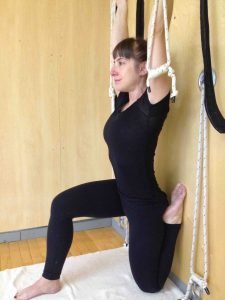In Honour of Backbends Week
Published on May 19, 2013
Urdhva Dhanurasana
Lifting from the floor, using the wall. Even though I’m using the wall, my buttocks still sinks. I can’t quite seem to get enough purchase through the feet to move the tailbone and sacrum in and up.
Not too long ago, I was in a class where my teacher was taking us through some fairly intense backbends. I suffered my way through. I felt like my body was not yet ready for the more advanced presentations of Urdhva Dhanurasana and Dwi Pada Viparita Dandasana she was teaching. Why did I feel this way? Well for one, I felt like I was losing control of my legs. I couldn’t control my feet or my thighs, nor could I address any of the nuances of the pose. It was all and only about lifting myself up and then letting myself come down before I fell from exhaustion. Not very yogic, huh? So… I swallowed my pride, backed up my poses and worked with a chair and the wall instead of lifting up off the floor.
Urdhva Dhanurasana
Lifting up from the chair. In this version, my buttocks isn’t sinking quite as much, but my thighs are splaying out despite all my efforts to roll them in.
Even still, I had trouble controlling my limbs.
However, these presentations at least gave some boundaries to my pose. I felt good about the decision and quite honestly I’m comfortable with the fact that for me, right now, this is where I’m at with these particular poses. That said, I’d absolutely like to move beyond this place. I’m determined to, one day, do a better backbend.
I began to wonder if practicing these poses more often would help me improve. My gut response was that actually, no, I don’t think I need to practice these poses more often. In fact, I felt that I needed to practice other poses more often. Given how challenging these poses are for me, I wondered if this was a cop out or if there was truth to how I was feeling. I consulted my books and my practice and decided that my logic was sound. I also concluded that the number one thing holding me back from doing better backbends was/is the fact that my middle groins are exceptionally tight. So for now, my plan is to address my tight middle groins in an effort to improve my back bends.
Here are some photos of things I’ve recently inserted into my practice to achieve this end.
Below are some excerpts from a talk BKS Iyengar gave on Backbends. These words have been highly instructive and illuminating for me. I hope you enjoy them as well. Happy backbends week!!
BKS Iyengar on Backbends…
“Backbends are not taught at the early stages in the practice of the this art, but only when the body is trained, tuned and toned to such an extent that it accepts these poses.”
“Backbends are to be felt more than expressed. The other postures can be expressed and then felt. Like in meditation each person has to feel backbends.”
“Backbends are not poses meant for expressionism. Backbends are meant to understand the back parts of our bodies. The front body can be seen with the eyes, but the back body can only be felt. That’s why I say these are the most advanced postures, where the mind begins to look at the back. Otherwise it is felt on the peripheral level.”
“For a yogi, the backbending asanas are meant to invert the mind, to look in and back, to feel the actual back portion of the body.”
“It is my feeling that one who knows, and looks into the back can look into God.”
“Without the accurate spine movement, one can’t exist dynamically.”
“Backbends demand a certain standard both in the body and the mind.”
“…backbends are like a third eye. The third eye means strength and power within to face the unseen light when it falls on you or me.”
“Inversions work on certain parts of the body; standing poses work on certain parts of the body, and so the twists and balances. But the understanding of penetration of the mind on the spinal nerves and spinal muscles are not touched by the above poses except in backbends.”
“Practitioners should try only after they’ve mastered particularly the standing poses, twists and inversions. The question of balancings are unimportant for backbends, but the others have to come. They are the base for backbends.”
“Tadasana is the base for standing poses. Janu Sirsasana is the base for forward bends. In inverted poses, Sarvangasana is the base. In balancings, Bakasana is the base. In backbends, Urdhva Dhanurasana is the base.”
“…you create tremendous depth and vastness in the chest through the backbends that the emotional centre accommodates [absorbs and withstands] all types of pressures and strains. There is no chance for a person who does backbends to get emotionally depressed or distressed.”
“The beauty of backbends is that the person remains intellectually stable – not strong.”
“Backbends give stability to the body and bring maturity in the intelligence in order to develop ripeness in the brain and ripeness in the emotions”.
“When one does a lot of backbends, the blood is circulated with such speed and force that one feels hot in the body. As that body becomes warmer than normal, soothing or cooling poses have to be taught afterwards. Soothing and cooling poses like Adho Mukha Svanasana, Adho Mukha Virasana, bending downwards, and lateral Uttanasana, bring the body temperature back to normal. This is the natural ‘pill’ in yoga, to come back to a natural state.”
“I also say with backbends, you have to be cautiously bold. Not carelessly bold. You have to descend to the dictation of the spine. You cannot command from the brain to do the poses. As you play with a child, guarding the child from injuries, similarly you have to play in backbends, guarding your spine.”
“Keep the mind, the intelligence and will power in such a state that they may not trespass and disturb the body.”
When one does backbends, one has to think and rethink. One has to start from the beginning.”
“Healthy adjustments are very essential and important: Positioning of the cells, positioning of the spinal vertebrae, positioning of the joints, how to squeeze, how to stretch, are all to be digested.”
“In other poses the sternum is touched from the outside, while in backbends one touches from inside. This helps us to educate the mind both ways. In Sirsasana , or forward bends or balancings, the mind acts as extrovert. In backbendings, mind goes within. With both, one hits the inner mind within and without using the body as a means.”
“In forward bends, one uses the outer mind while in backbends the outer mind is silenced and the inner mind is made to work.”
“In backbends, one touches the body physically, mentally, intellectually, consciously and spiritually everywhere.”
“That’s the beauty of backbends. Emotionally we can never be disturbed, for the emotional centre becomes an extrovert. When you do Viparita Dandasana, your head looks backwards, but your conscious mind stretches everywhere. Study by observing how the mind gets regulated. You not only know the freedom in the spine, but also the freedom in the spirit.”
What is your experience with backbends? Care to share any tips, thoughts or experiences?





